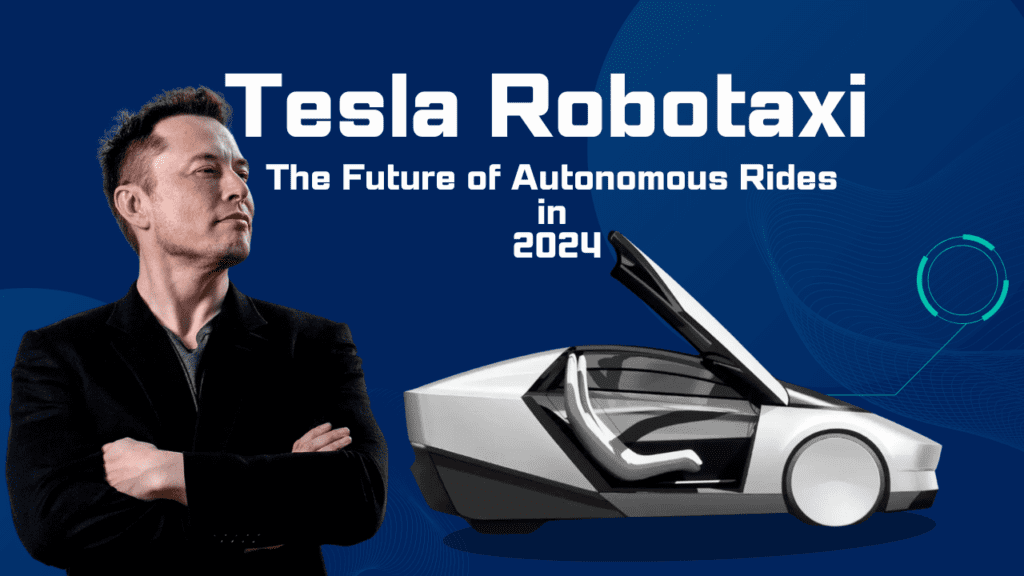The concept of the Tesla Robotaxi has generated significant buzz in the automotive and tech industries. As we move into 2024, this innovative service promises to reshape how we think about transportation. In this article, we will explore the features, implications, and future of Tesla’s autonomous taxi service.
What is the Tesla Robotaxi?
The Tesla Robotaxi is an autonomous vehicle designed to operate without human intervention. This means that it will transport passengers from one location to another using advanced artificial intelligence and a network of sensors. With no need for a driver, Tesla aims to provide a more efficient and cost-effective transportation solution.
Key Features of the Tesla Robotaxi
- Fully Autonomous Driving: The Tesla Robotaxi utilizes cutting-edge technology to navigate complex urban environments.
- Cost Efficiency: By eliminating the need for a driver, Tesla aims to reduce operational costs significantly.
- Safety Features: Advanced safety systems are integrated to ensure passenger safety during rides.
- Seamless Integration: The robotaxi will be part of the broader Tesla ecosystem, allowing for easy access through the Tesla app.
The Technology Behind the Tesla Robotaxi
Understanding the technology behind the Tesla Robotaxi is crucial. Tesla employs a combination of hardware and software to achieve full autonomy. This includes:
Hardware Components
The hardware used in the Tesla Robotaxi includes an array of cameras, ultrasonic sensors, and radar systems. These components work together to create a 360-degree view of the vehicle’s surroundings, allowing it to detect obstacles, pedestrians, and other vehicles.
Software Algorithms
The software algorithms developed by Tesla are responsible for processing data from these sensors. Using machine learning techniques, the system continuously improves its decision-making capabilities. As a result, the robotaxi can adapt to various driving conditions and environments.
The Economic Impact of Tesla’s Robotaxi Service
The introduction of the Tesla Robotaxi is expected to have far-reaching economic implications. Here are some potential impacts:
Job Displacement and Creation
While some driving jobs may be displaced due to automation, new opportunities will emerge in technology development, maintenance, and customer support roles. Therefore, a shift in job types is anticipated rather than an outright loss of employment.
Cost Savings for Consumers
With lower operational costs, users can expect reduced fares compared to traditional taxi services. This affordability could encourage more people to utilize ride-sharing options, leading to increased demand for autonomous services.
Regulatory Challenges Facing the Tesla Robotaxi
The rollout of the Tesla Robotaxi will not be without challenges. Regulatory hurdles must be navigated before widespread adoption can occur.
Legal Frameworks
Governments worldwide are still developing legal frameworks for autonomous vehicles. These regulations will dictate how robotaxis can operate in various regions. Consequently, compliance with local laws will be essential for Tesla’s success.
Public Perception and Trust
The public’s trust in autonomous technology plays a significant role in its acceptance. Education campaigns may be necessary to alleviate concerns regarding safety and reliability. Moreover, transparency about how the technology works can foster greater confidence among potential users.
The Competition: How Does Tesla Stand Out?
The Tesla Robotaxi enters a competitive market filled with other autonomous vehicle initiatives. However, several factors set Tesla apart from its competitors:
Brand Recognition and Trust
Tesla has established itself as a leader in electric vehicles (EVs) and autonomous driving technology. This brand recognition provides a significant advantage when launching new services like the robotaxi.
Innovative Technology
The company’s commitment to innovation ensures that its robotaxi service will leverage state-of-the-art technology. As a result, Tesla’s offerings are often seen as more advanced compared to those from competitors.
User Experience: What Can Passengers Expect?
The user experience with the Tesla Robotaxi is designed to be seamless and enjoyable. Passengers can anticipate several features aimed at enhancing their journey:
Simplified Booking Process
Using the Tesla app, users can easily book a ride with just a few taps on their smartphones. This streamlined process makes it convenient for passengers to access transportation quickly.
Comfortable Ride Quality
Tesla vehicles are known for their comfort and performance. The robotaxi will maintain these standards, providing passengers with a smooth ride experience.
The Future of Transportation: A Vision Beyond 2024
The introduction of the Tesla Robotaxi marks just the beginning of a broader transformation in transportation. Looking beyond 2024, several trends are likely to emerge:
Sustainable Transportation Solutions
The shift toward electric autonomous vehicles aligns with global sustainability goals. As more people opt for robotaxis over personal cars, urban congestion may decrease significantly.
Integration with Smart Cities
As cities become smarter through technology integration, robotaxis could play a pivotal role in urban mobility solutions. Their ability to communicate with traffic systems may optimize routes and reduce travel times.
Conclusion: Embracing Change with Tesla’s Robotaxi
The Tesla Robotaxi represents an exciting leap forward in transportation technology. As we approach 2024, its potential impact on society cannot be understated. From economic implications to regulatory challenges and user experiences, many factors will shape this innovative service’s future.
This journey into autonomous transportation invites everyone to embrace change positively. With ongoing advancements in technology and growing public acceptance, the future looks bright for Tesla’s robotaxi initiative.
The Competitive Landscape
The introduction of the Tesla Robotaxi places it in direct competition with established players like Waymo and Cruise. These companies have already deployed autonomous taxi services in select areas, creating a challenging environment for Tesla as it seeks to carve out its niche.
Comparison with Competitors
| Feature | Tesla Robotaxi | Waymo | Cruise |
|---|---|---|---|
| Autonomy Level | Level 5 | Level 4/5 | Level 4/5 |
| Technology Used | Cameras & AI | LiDAR & Cameras | LiDAR & Cameras |
| Current Deployment | Pending Approval | Select Cities | Select Cities |
| Expected Price | $30,000+ | N/A | N/A |
The Future of Transportation with Tesla Robotaxi
The implications of introducing robotaxis extend beyond just personal convenience; they could reshape urban infrastructure and reduce traffic congestion. As cities adapt to accommodate these vehicles, significant changes may occur in public transportation systems and urban planning.
Sustainability Considerations
The shift towards electric and autonomous vehicles like the Tesla Robotaxi aligns with global sustainability goals. By reducing reliance on fossil fuels and optimizing traffic flow through AI-driven technology, these vehicles could contribute positively to environmental efforts.
User Experience and Accessibility
The design of the Tesla Robotaxi prioritizes passenger comfort and accessibility. With spacious interiors and advanced infotainment systems, passengers can enjoy a seamless travel experience. Furthermore, as these vehicles become more prevalent, they may offer increased mobility options for individuals who are unable to drive.
Potential Challenges in User Adoption
Despite its promising features, user adoption may face hurdles due to concerns about safety and reliability. Public perception plays a crucial role in determining whether consumers will embrace this new mode of transportation.
The Role of AI in Autonomous Driving
A significant aspect of the Tesla Robotaxi’s functionality hinges on artificial intelligence. The vehicle’s ability to learn from real-world scenarios enhances its navigational capabilities. As AI technology continues to evolve, so too will the performance of autonomous vehicles.
The Importance of Data Collection
Tesla’s extensive data collection from its fleet contributes to improving its FSD system. This data-driven approach allows for continuous updates and enhancements to the robotaxi’s software, ensuring it remains competitive in an ever-evolving market.
The Road Ahead for Tesla Robotaxi
The journey towards realizing Elon Musk’s vision for the Tesla Robotaxi is both exciting and challenging. With ambitious production timelines and regulatory hurdles ahead, only time will tell how successfully this innovative vehicle can integrate into our daily lives. As we look towards 2024 and beyond, one thing is certain: the future of transportation is rapidly changing.
Read more on Amazing Facts & Top 10:
- Get More Facts on our Website
- Tech Titans: Unveiling the Secrets Behind Silicon Valley’s Giants
- 10 Customized GPT Models That Improve ChatGPT’s Performance
- Unlocking the Mysteries: 20 Amazing Human Body Facts You Won’t Believe Are True
- Top 13 Famous Indian Bloggers with Highest Income in 2024
- 15 Amazing Facts About Human Behavior You Must Know
- India’s Top 10 Most Subscribed YouTube Channels in 2024
- 50 Amazing Facts You Didn’t Know About the World
- The Ultimate Guide to SEO for Indian Blogs: 10 Tips and Tools
- The Top 10 Indian Celebrity News Blogs: Ranking and Analysis
- The Top 10 Indian Travel Blogs: Destinations, Tips, and Tales
- The Top 10 Indian Fashion Blogs: Trends, Style, and Inspiration
- The Top 10 Indian Fitness Blogs: Workouts, Nutrition, and Motivation
- Top 10 Fascinating Facts About Digital Marketing
- Unveiling 10 Mind-Blowing AI Innovations in Tech
- Top 10 Best Indian Politicians in 2024
- Revolutionizing AI Interactions: OpenAI Unveils GPT-0, Elevating ChatGPT’s Capabilities Across Text, Visual, and Audio Dimensions
- OpenAI Unveils GPT-4O: A Groundbreaking Multimodal AI Model
- The Best iPads of 2024
- 32 Amazing Facts About India You Probably Don’t Know Yet
- 10 Surprising Benefits of Minimalist Living in 2024
- 10 Unbelievable Science Facts That Will Blow Your Mind
- Fun Facts About Penguins: Nature’s Adorable Birds
- The Top 10 Indian Food Blogs: Recipes, Reviews, and Rankings
- Weird Facts About the Human Body You Never Knew
- Interesting Facts About Life That Will Change Your Perspective
- Tesla Robotaxi: The Future of Autonomous Rides in 2024
- Top 10 Must-Read Books of 2024
- Top 10 Healthy Recipes for Busy Families
- Top 10 Travel Destinations in the USA for 2024
- Top 10 Tech Gadgets You Can’t Live Without
- Top 10 Movies to Watch This Fall
- Top 10 Fitness Trends to Try This Year
- Top 10 Most Influential Women in Business
- Top 10 Tips for First-Time Home Buyers
- Top 10 Historical Sites to Visit in the USA
- Top 10 Ways to Save Money on Groceries
- Top 10 Podcasts You Should Be Listening To



